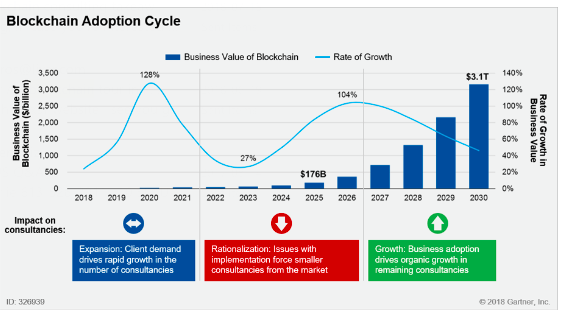|
Remember 2017? You couldn't get on LinkedIn without seeing tons of articles about all the different industries that blockchain was going to disrupt. Blockchain was at the top of Gartner's "hype cycle" and, if you read a little further into their report, was expected to transition into the trough of disillusionment. So where is Blockchain now? Today blockchain is in a sort of holding pattern. Gartner published a survey asking CIOs about their blockchain plans:
Wikipedia emphasizes blockchain has massive potential, but again over long-term - "Blockchain technology has a large potential to transform business in the long term. Blockchain distributed ledger technology is more a foundational technology—with the potential to create new foundations for global economic and social systems—than a disruptive technology, which typically "attack a traditional business model with a lower-cost solution and overtake incumbent firms quickly" The use of blockchains promises to bring significant efficiencies to global supply chains, financial transactions, asset ledgers and decentralized social networking." So what is the hold up? Technological Constraints Just as IoT has some practical limitations that it needs to overcome to go more mainstream, Blockchain technology has some challenges detailed here, namely:
According to Gartner "in later phases of a blockchain initiative, key technical limitations of existing blockchain platforms become major issues. The lack of scalability to real-world transaction volumes, complexity in managing data and problems integrating with legacy systems will all create problems. If these issues are overcome and a pilot is undertaken, then many projects still fail to progress to full implementation due to the need to engage substantial numbers of other organizations in the solution. Often, such organizations will not wish to participate, due to competing or limited interests in a blockchain project, or due to substantial investments in their own solutions. For some of the most complex blockchain use cases, the on-boarding and maintenance of the ecosystem, setting standards, and monitoring behaviour are the biggest barriers to scale. Even with a workable blockchain offering today, these issues mean it still might take 10 years to scale because of this." Where is the Short-Term Investment for Blockchain happening? There’s certainly no shortage of investment at this very moment into Blockchain tech by Microsoft and IBM. Over 50% of the practical, real-world investment into blockchain projects so far has been in banking&finance, as well as supply chain use cases in various industries, according to various sources such as this Microsoft conference. One place to look at where short-term technology breakthroughs are happening is by looking at the consulting world. Gartner sums up the highlights of Blockchain consulting here:
My own experience followed this curve - my team prototyped our new security product with Blockchain to showcase to investors, and it certainly got them excited! But once the company was acquired, reality set back in and we focused on delivering immediately commercial functionality, with blockchain pushed further out on the roadmap. The Blockchain Adoption Cycle: How Will It All Unfold? With the backing of MS, IBM and other mega-corporations backing the long-term of the technology, the question of Blockchain is not "if" but "when". Gartner has a fantastic graph that predicts how it's going to unfold: an initial spike by 2020 in ideation and PoC consulting, but the tech will not have caught up, at which point there will be a slowdown in interest, driving firms who are not fully committed to give up and look elsewhere. Those that stick with it however and get enough PoCs under their belts would be rewarded starting in 2024 and beyond as the tech catches up and real-world projects become possible.
0 Comments
Your comment will be posted after it is approved.
Leave a Reply. |


